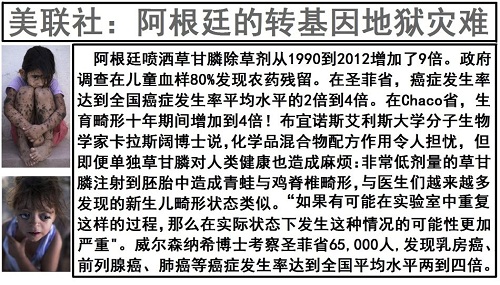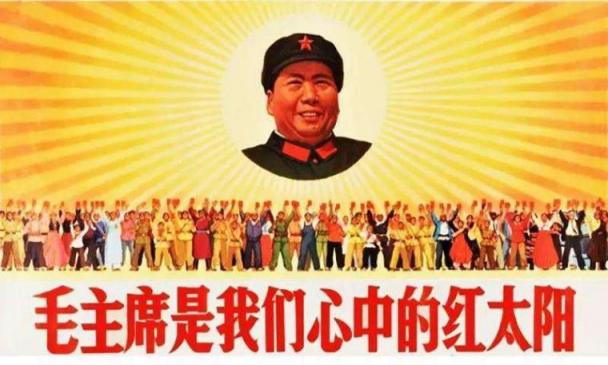阿根廷噴灑的草甘膦除草劑從1990年到2012年增加了9倍。政府調(diào)查在兒童血樣的80%發(fā)現(xiàn)農(nóng)藥殘留。在圣菲省,癌癥發(fā)生率達(dá)到全國(guó)癌癥發(fā)生率平均水平的2倍到4倍。在Chaco省,生育畸形十年期間增加到4倍!布宜諾斯艾利斯大學(xué)分子生物學(xué)家卡拉斯闊博士說,化學(xué)品混合物配方作用令人擔(dān)憂,但即便單獨(dú)草甘膦對(duì)人類健康也造成麻煩:非常低劑量的草甘膦注射到胚胎中造成青蛙與雞脊椎畸形,與醫(yī)生們?cè)絹碓蕉喟l(fā)現(xiàn)的新生兒畸形狀態(tài)類似。“如果有可能在實(shí)驗(yàn)室中重復(fù)這樣的過程,那么在實(shí)際狀態(tài)下發(fā)生這種情況的可能性更加嚴(yán)重”。威爾森納希博士決定找出阿根廷醫(yī)院中癌癥、新生兒畸形與流產(chǎn)劇增后邊的原因。2010年以來,一家一戶進(jìn)行的流行病學(xué)研究考察了圣菲省65,000人,發(fā)現(xiàn)不同地區(qū)乳房癌、前列腺癌、肺癌等癌癥發(fā)生率達(dá)到全國(guó)平均水平兩倍到四倍。

Argentina's Genetically Engineered Hell
阿根廷的轉(zhuǎn)基因地獄災(zāi)難
http://www.gmeducation.org/food-and-health/p216779-argentina-s-genetically-engineered-hell.html
轉(zhuǎn)載自(美國(guó))轉(zhuǎn)基因教育網(wǎng)站 2013年10月22日發(fā)布的節(jié)錄文章
Doctors are warning that uncontrolled pesticide applications could be the cause of devastating health problems among the 12 million people who live in Argentina's farm belt. News agency Associated Press has compiled a report which makes appalling reading. The following edited extracts highlight the human costs of Argentina's GM 'miracle.'
醫(yī)生警告農(nóng)藥失控濫用可能是阿根廷密集種植農(nóng)業(yè)區(qū)域1200萬人災(zāi)難性健康問題的根源。美聯(lián)社撰寫了一篇閱讀起來令人恐懼的報(bào)告。下邊編輯節(jié)錄的內(nèi)容揭示阿根廷轉(zhuǎn)基因“奇跡”的人類健康代價(jià)。
Schoolteacher Andrea Druetta lives in Santa Fe Province, the heart of Argentina's soy country, where agrochemical spraying is banned within 500 meters (550 yards) of populated areas.
安德里·德魯塔,一位學(xué)校老師居住在圣菲省,阿根廷大豆種植區(qū)域核心地帶,那里禁止在居民區(qū)500公尺距離范圍噴灑農(nóng)業(yè)化學(xué)品。
But soy is planted just 30 meters (33 yards) from her back door. Her boys were showered in chemicals recently while swimming in the backyard pool.
但是,大豆一直種植到她家后門30公尺處。她的兒子們?cè)诤笤撼靥劣斡緯r(shí)被噴灑了農(nóng)業(yè)化學(xué)品。
After Sofia Gatica lost her newborn to kidney failure, she filed a complaint that led to Argentina's first criminal convictions for illegal spraying. But last year's verdict came too late for many of her 5,300 neighbours in Ituzaingo Annex.
索菲亞·尕提卡的新生兒因腎衰竭死亡后,她起訴了噴灑農(nóng)藥者,成為阿根廷對(duì)于非法噴灑農(nóng)藥犯罪起訴第一案。但是,對(duì)于她Ituzaingo Annex地方5,300位鄰居而言,去年的裁決來的太遲。
A government study there found alarming levels of agrochemical contamination in the soil and drinking water, and 80 percent of the children surveyed carried traces of pesticide in their blood.
一項(xiàng)政府調(diào)查發(fā)現(xiàn)土壤中與飲水中檢測(cè)到令人警覺水平的農(nóng)業(yè)化學(xué)品污染,還發(fā)現(xiàn)進(jìn)行了檢測(cè)的兒童的血液中80%發(fā)現(xiàn)農(nóng)藥殘留。
In Santa Fe, cancer rates are two times to four times higher than the national average. In Chaco, birth defects quadrupled in the decade after biotechnology dramatically expanded farming in Argentina.
在圣菲省,癌癥發(fā)生率達(dá)到全國(guó)癌癥發(fā)生率平均水平的2倍到4倍。在Chaco省,阿根廷轉(zhuǎn)基因作物迅速擴(kuò)展以后,生育畸形十年期間增加到4倍!
"The change in how agriculture is produced has brought, frankly, a change in the profile of diseases," says Dr. Medardo Avila Vazquez, a paediatrician and neonatologist who co-founded Doctors of Fumigated Towns, part of a growing movement demanding enforcement of agricultural safety rules. "We've gone from a pretty healthy population to one with a high rate of cancer, birth defects, and illnesses seldom seen before."
“農(nóng)業(yè)中農(nóng)產(chǎn)品生產(chǎn)方式的改變帶來,坦率的說,疾病構(gòu)成的變化”,梅達(dá)拉多·阿維拉·瓦奎斯醫(yī)生說,他是兒科醫(yī)生與新生兒學(xué)專家,合作創(chuàng)立了《受農(nóng)藥熏蒸市鎮(zhèn)的醫(yī)生》,要求強(qiáng)化農(nóng)業(yè)安全法規(guī)運(yùn)動(dòng)的一部分。“我們已經(jīng)從原本相當(dāng)健康人民,變成了癌癥、新生兒畸形與過去少見疾病高發(fā)病率”。
The pall of poison
毒影籠罩之下
GMO technology and the toxic herbicides and pesticides that go with it have turned Argentina into the world's third-largest soybean producer. Today, its entire soy crop and nearly all its corn and cotton are genetically modified, with soy cultivation alone tripling to 47 million acres (19 million hectares).
轉(zhuǎn)基因技術(shù)以及伴隨的有毒除草劑和農(nóng)藥,將阿根廷變成世界第三大大豆生產(chǎn)國(guó)。今天,阿根廷種植的大豆、玉米與棉花幾乎全部是轉(zhuǎn)基因作物,大豆種植面積高達(dá)4700萬英畝(1900萬公頃)。
But the chemicals powering the boom aren't confined to soy and cotton and corn fields. The Associated Press documented dozens of cases around the country where poisons are applied in ways unanticipated by regulatory science or specifically banned by existing law.
但是,驅(qū)動(dòng)轉(zhuǎn)基因作物大規(guī)模種植的農(nóng)業(yè)化學(xué)品不限于對(duì)轉(zhuǎn)基因大豆、棉花與玉米農(nóng)田的噴灑。美聯(lián)社收集到數(shù)十個(gè)案例,表明這些毒性農(nóng)用化學(xué)品正在以監(jiān)管性科學(xué)未曾預(yù)料的方式以及現(xiàn)有法律禁止的方式使用。
l The spray drifts into schools and homes and settles over water sources; farm workers mix poisons with no protective gear; villagers store water in pesticide containers that should have been destroyed.
l 噴灑的農(nóng)藥漂流進(jìn)入學(xué)習(xí)與居民區(qū),落到水源區(qū)域;農(nóng)業(yè)工人混合這些毒性化學(xué)品時(shí)不戴任何保護(hù)性裝置;農(nóng)村居民用毒性農(nóng)藥容器儲(chǔ)存水,而不是將它們處理掉。
l Spraying is banned within 3 kilometres (1.9 miles) of populated areas in some provinces and as little as 50 meters (55 yards) in others. About one-third Argentina’s provinces set no limits at all, and most lack detailed enforcement policies.
l 某些省規(guī)定禁止在居民區(qū)距離3公里范圍內(nèi)噴灑有毒農(nóng)用化學(xué)品,有些省份規(guī)定的禁止噴灑距離范圍卻只有50工程。阿根廷大約三分之一的省對(duì)此沒有任何限制,而且絕大部分省份缺乏強(qiáng)制性政策。
l With soybeans selling for about $500 a ton, growers plant where they can, often disregarding guidelines and provincial law by spraying without giving advance warning, and even in windy conditions.
l 大豆每噸售價(jià)500美元情況下,種植者在能夠種植的所有地方進(jìn)行種植,往往忽視相關(guān)的指導(dǎo)原則與省法規(guī),噴灑時(shí)不提前告知,甚至在刮風(fēng)條件下也這樣。
l In Entre Rios, teachers reported that sprayers failed to respect 50-metre (55-yard) limits at 18 schools, dousing 11 during class. Five teachers filed police complaints this year.
l 在Entre Rios地方,老師們報(bào)告:農(nóng)業(yè)化學(xué)品噴灑者在18個(gè)學(xué)校周圍不尊重50公尺禁止噴灑的規(guī)定,甚至在11個(gè)學(xué)校上課時(shí)繼續(xù)噴灑。僅今年,已經(jīng)有五位老師對(duì)此向警察提出舉報(bào)。
l Druetta also filed complaints in Santa Fe, alleging that students fainted when pesticides drifted into their classrooms and that their tap water is contaminated. She is struggling to get clean drinking water into her school, she said, while a neighbour keeps a freezer of rabbit and bird carcasses, hoping someone will test them to see why they dropped dead after spraying.
l 德魯特老師在圣菲向警察也提出這樣的舉報(bào),申訴她的學(xué)生們因噴灑的農(nóng)藥漂流進(jìn)入課堂而昏厥,同時(shí)造成自來水污染。她努力保證學(xué)校能夠提供清潔的飲用水,一位鄰居在冰箱中保存著兔子和鳥的尸體,希望有人能夠檢測(cè)它們,確認(rèn)它們?yōu)槭裁丛谵r(nóng)藥噴灑后落地而死。
l Buenos Aires forbids loading or hosing off spraying equipment in populated areas, but in the town of Rawson, it's done directly across the street from homes and a school, with the run-off flowing into an open ditch.
l 阿根廷的首都布宜諾斯艾利斯禁止在人口地區(qū)安裝或卸下農(nóng)業(yè)化學(xué)品噴灑設(shè)備,但是Rawson市,居住區(qū)與學(xué)校馬路對(duì)面,有人卻這樣做,并且放任農(nóng)業(yè)化學(xué)品泄露流到開放的溝渠。
l Felix San Roman says that when he complained about clouds of chemicals drifting into his yard, the sprayers beat him up, fracturing his spine and knocking out his teeth. He said he filed a complaint in 2011, but it was ignored.
l 菲利克斯·桑·羅曼說,他對(duì)于農(nóng)業(yè)化學(xué)品霧飄到他的院子中提出了抱怨,結(jié)果被噴灑者打了一頓,造成脊裂,還打掉他的牙齒。他說他2011年注冊(cè)了舉報(bào),但是至今遭到忽視。
l In January, activist Oscar Di Vincensi stood in a field near a friend's house waving a court ruling against spraying within 1,000 meters (1,100 yards) of homes in his town of Alberti. A tractor driver simply ignored him, dousing him in pesticide. Di Vincensi's video of that incident went viral on YouTube earlier this year.
l 1月份,活動(dòng)家奧斯卡·迪·文森斯站在一位朋友的房子附近,搖晃法庭裁決禁止本地在居住區(qū)距離1公里范圍內(nèi)噴灑農(nóng)藥的告示。噴灑農(nóng)藥的拖拉機(jī)手完全忽視他,將農(nóng)藥噴灑到他的身上。迪·文森斯關(guān)于這個(gè)事件的錄像上網(wǎng)到YouTube后受到瘋轉(zhuǎn)。
Safe if it’s used properly?
農(nóng)業(yè)化學(xué)品如果正確使用是否安全?
Right at the centre of Argentina’s agricultural revolution is Monsanto’s patented crops and its glyphosate herbicide, Roundup.
阿根廷農(nóng)業(yè)“革命”的核心是孟山都專利的轉(zhuǎn)基因作物及其草甘膦除草劑農(nóng)達(dá)。
According to Associated Press’ analysis of government and pesticide industry data agrochemical use in Argentina did decline at first, then it bounced back, increasing nine-fold from 9 million gallons (34 million liters) in 1990 to more than 84 million gallons (317 million litres) today as farmers squeezed in more harvests and pests became resistant to the poisons.
根據(jù)美聯(lián)社對(duì)于政府與農(nóng)藥產(chǎn)業(yè)農(nóng)業(yè)化學(xué)品在阿根廷使用數(shù)據(jù)的分析,它們開始使用后發(fā)生減少然后跳回并上升,從1990年大約900萬加侖(3400萬公升)急劇增多9倍2012年達(dá)到8400萬加侖(3.17億公升),每季噴灑更多的農(nóng)藥以便對(duì)付不斷增長(zhǎng)的抗性。
Overall, Argentine farmers apply an estimated 4.3 pounds of agrochemical concentrate per acre, more than twice that U.S. farmers use.
總體講,阿根廷的農(nóng)民每英畝預(yù)計(jì)噴灑4.3磅農(nóng)業(yè)化學(xué)品,為美國(guó)農(nóng)民用量高一倍。
Regulatory agencies, including those of the United States and European Union have determined the Roundup is safe if it’s applied properly.
美國(guó)與歐盟等國(guó)監(jiān)管機(jī)構(gòu),都確定草甘膦除草劑農(nóng)達(dá)是安全的,如果正確應(yīng)用的話。
On May 1, the U.S. Environmental Protection Agency even raised the allowable levels of glyphosate residues in food.
美國(guó)環(huán)境保護(hù)署(EPA)2013年5月1日甚至宣布提高食品中的草甘膦最高殘留限量。
US EPA raises levels of glyphosate residue allowed in food
美國(guó)環(huán)保署(EPA)提高食物中允許的草甘膦殘留水平
http://news.agropages.com/News/NewsDetail---10116.htm
中譯文:http://blog.sina.com.cn/s/blog_4bb17e9d0102e96e.html
But these decisions are based on industry research which critics say are inadequate and do not cover interactions of the “cocktail effect” when different agro-chemicals are used together.
但是這些決定僅基于產(chǎn)業(yè)界自己的研究,其批評(píng)者說,這些研究不足而且不包括將不同農(nóng)用化學(xué)品混合在一起配方的“雞尾酒作用”。
Molecular biologist Dr. Andres Carrasco at the University of Buenos Aires says the burden from the chemical cocktails is worrisome, but even glyphosate alone could spell trouble for human health.
阿根廷布宜諾斯艾利斯大學(xué)分子生物學(xué)家安德雷斯·卡拉斯闊博士說,化學(xué)品混合物配方的作用令人擔(dān)憂,但是即便草甘膦單獨(dú)也能夠?qū)θ祟惤】翟斐陕闊?/strong>
He found that injecting a very low dose of glyphosate into embryos can change levels of retinoic acid, causing the same sort of spinal defects in frogs and chickens that doctors increasingly are registering in communities where farm chemicals are ubiquitous.
他發(fā)現(xiàn),即便將非常低劑量的草甘膦注射到胚胎中也改變視黃酸的水平,造成青蛙與雞脊椎畸形,與醫(yī)生們?cè)谵r(nóng)用化學(xué)品無處不在區(qū)域社區(qū)中越來越多發(fā)現(xiàn)的新生兒畸形狀態(tài)類似。
This acid, a form of vitamin A, is fundamental for keeping cancers in check and triggering genetic expression, the process by which embryonic cells develop into organs and limbs.
這種視黃酸是維生素A的一種,對(duì)于維持對(duì)于癌的(生物性)檢查和觸發(fā)相應(yīng)的基因表達(dá)使胚胎細(xì)胞發(fā)育為器官和四肢的過程至關(guān)重要。
"If it's possible to reproduce this in a laboratory, surely what is happening in the field is much worse," Carrasco said. "And if it's much worse, and we suspect that it is, what we have to do is put this under a magnifying glass."
“如果有可能在實(shí)驗(yàn)室中重復(fù)這樣的過程,那么在實(shí)際狀態(tài)下發(fā)生這種情況的可能性更加嚴(yán)重”,卡拉斯闊教授說。“如果如此更加嚴(yán)重,而且我們懷疑是這樣,我們就必須將這種狀況放到放大鏡下進(jìn)行研究。”
A catalogue of cancers, miscarriages and birth defects
癌癥、流產(chǎn)與生育缺陷不同情況的比較
Dr. Damian Verzenassi, who directs the Environment and Health program at the National University of Rosario's medical school, decided to try to figure out what was behind an increase in cancer, birth defects and miscarriages in Argentina's hospitals.
達(dá)米安·威爾森納希博士,負(fù)責(zé)羅薩里奧國(guó)立大學(xué)醫(yī)學(xué)院環(huán)境與健康研究機(jī)會(huì),決定找出阿根廷醫(yī)院中癌癥、新生兒畸形與流產(chǎn)劇增后邊的原因。
"We didn't set out to find problems with agrochemicals. We went to see what was happening with the people," he said.
“我們并不是從尋找農(nóng)用化學(xué)品的問題出發(fā)進(jìn)行這項(xiàng)研究。我們是為了找到對(duì)人民究竟發(fā)生了什么事而去從事這項(xiàng)研究”,他說。
Since 2010, this house-to-house epidemiological study has reached 65,000 people in Santa Fe province, finding cancer rates two times to four times higher than the national average, including breast, prostate and lung cancers. Researchers also found high rates of thyroid disorders and chronic respiratory illness.
2010年以來,這個(gè)一家一戶進(jìn)行的流行病學(xué)研究已經(jīng)考察了圣菲省65,000人,發(fā)現(xiàn)(圣菲省不同地區(qū))乳房癌、前列腺癌、肺癌等癌癥發(fā)生率達(dá)到全國(guó)平均水平的兩倍到四倍。研究者們還發(fā)現(xiàn)高發(fā)生率的甲狀腺十條與慢性呼吸系統(tǒng)疾病。
"It could be linked to agrochemicals," he said. "They do all sorts of analysis for toxicity of the first ingredient, but they have never studied the interactions between all the chemicals they're applying."
“這些疾病可能與農(nóng)業(yè)化學(xué)品關(guān)聯(lián)”,他說。“它們對(duì)其中頭一個(gè)成分的毒性做了各種各樣的分析,但是從來沒有研究過他們應(yīng)用的配方的所有化學(xué)品的相互作用。”
Dr. Maria del Carmen Seveso, who has spent 33 years running intensive care wards and ethics committees in Chaco province, became alarmed at regional birth reports showing a quadrupling of congenital defects, from 19.1 per 10,000 to 85.3 per 10,000 in the decade after genetically modified crops and their agrochemicals were approved in Argentina.
瑪麗亞·卡門·斯維索博士,在查科省管理重癥監(jiān)護(hù)病房和倫理委員會(huì)已經(jīng)33年,看到該地區(qū)生育報(bào)告表明先天性缺陷字轉(zhuǎn)基因作物及其農(nóng)用化學(xué)品在阿根廷批準(zhǔn)商業(yè)化使用后十年期間從19.1/萬人增加為四倍達(dá)到85.3/萬人后,引起了警覺。
Determined to find out why, she and her colleagues surveyed 2,051 people in six towns in Chaco, and found significantly more diseases and defects in villages surrounded by industrial agriculture than in those surrounded by cattle ranches. In Avia Terai, 31 percent said a family member had cancer in the past 10 years, compared with 3 percent in the ranching village of Charadai.
決心找出為什么這樣的原因,她和她的同事在查科省對(duì)2,051人進(jìn)行了調(diào)查,發(fā)現(xiàn)周邊被工業(yè)化種植農(nóng)業(yè)圍繞的村莊,與周圍為養(yǎng)牛場(chǎng)的村莊相比,疾病與新生兒畸形顯著多。在Avia Terai,過去十年期間31%的家庭出現(xiàn)了癌癥患者,與此相比Charadai周圍為養(yǎng)牛場(chǎng)村莊只有3%的家庭出現(xiàn)了癌癥患者。
From the labs of Missouri to the fields of Argentina
從密蘇里州孟山都的實(shí)驗(yàn)室到阿根廷的現(xiàn)場(chǎng)農(nóng)田
US based Monsanto rejects any suggestion that its products are the cause of this devastation.
總部設(shè)在美國(guó)的孟山都拒絕它們產(chǎn)品是這些災(zāi)難原因的任何說法。
"Glyphosate is even less toxic than the repellent you put on your children's skin," said Pablo Vaquero, Monsanto's corporate affairs director in Buenos Aires. "That said; there has to be a responsible and good use of these products because in no way would you put repellent in the mouths of children and no environmental applicator should spray fields with a tractor or a crop-duster without taking into account the environmental conditions and threats that stem from the use of the product."
“草甘膦甚至比抹在你孩子皮膚上的護(hù)膚霜的毒性更低”,帕博羅·瓦奎羅,孟山都駐布宜諾斯艾利斯的公司事務(wù)主任說。“就是說;這些產(chǎn)品必須以負(fù)責(zé)任方式良好食用,因?yàn)槟阋膊荒軐⒆o(hù)膚霜放到孩子口中,而且沒有任何環(huán)境性應(yīng)用者可以用拖拉機(jī)或者撒農(nóng)藥機(jī)械而不考慮環(huán)境性條件以及產(chǎn)品使用可能提出的威脅。”
Out in the Argentine fields these warnings are widely ignored.
在阿根廷的農(nóng)田中,這些警告廣泛被忽略。
Visiting these farm villages, Associated Press found chemicals in places where they were never intended to be.
訪問了這些農(nóng)場(chǎng)村莊時(shí),美聯(lián)社發(fā)現(xiàn)這些農(nóng)業(yè)化學(xué)品放在它們從來沒打算用的地方。
Claudia Sariski, whose home has no running water, says she doesn't let her twin toddlers drink from the discarded poison containers she keeps in her dusty backyard. But her chickens do, and she uses it to wash the family's clothes.
克勞迪婭·薩利斯基,家里沒有自來水,說她不會(huì)讓她的雙胞胎孩子從滿是灰塵后院里丟棄的有毒化學(xué)品容器喝水。但是她的雞會(huì)喝那里的水,而且她會(huì)用這些容器中的水洗家里人的衣服。
"They prepare the seeds and the poison in their houses, and it's very common, not only in Avia Terai but in nearby towns, for people to keep water for their houses in empty agrochemical containers," explained surveyor Katherina Pardo. "Since there's no treated drinking water here, the people use these containers anyway. They are a very practical people."
“它們?cè)诩依餃?zhǔn)備種子與有毒化學(xué)品,而且,在丟棄的農(nóng)業(yè)化學(xué)品容器中盛水,這非常普遍,不僅在Avia Terai,而且在附近的市鎮(zhèn)也這樣”,調(diào)查員卡瑟琳·帕多解釋。“由于那里沒有經(jīng)過處理的飲水,當(dāng)?shù)厝藗兪褂眠@些容器。他們是非常實(shí)際的人們。”
The survey found diseases Seveso said were uncommon before - birth defects including malformed brains, exposed spinal cords, blindness and deafness, neurological damage, infertility, and strange skin problems.
調(diào)查中發(fā)現(xiàn)了斯維索博士說過去極少見的一些疾病 -- 包括大腦畸形,裸露脊髓、失明和失聰、神經(jīng)損傷等出生畸形,不生不育,以及一些奇怪的皮膚問題。
Aixa Cano, a shy 5-year-old, has hairy moles all over her body. Her neighbour, 2-year-old Camila Veron, was born with multiple organ problems and is severely disabled. Doctors told their mothers that agrochemicals may be to blame.
愛薩·卡諾,一位害羞的5歲女孩,多毛痣長(zhǎng)滿了全身。她的鄰居,2歲的卡米拉·維倫,出生時(shí)有多器官問題,嚴(yán)重殘疾。醫(yī)生告訴它們的媽媽,農(nóng)業(yè)化學(xué)品可能是罪魁禍?zhǔn)住?/strong>
"They told me that the water made this happen because they spray a lot of poison here," said Camila's mother, Silvia Achaval. "People who say spraying poison has no effect, I don't know what sense that has because here you have the proof," she added, pointing at her daughter.
“他們告訴我,水造成了這些問題,因?yàn)檫@里噴灑了許多有毒的化學(xué)品”,卡米拉的媽媽說。“有人說噴灑這些毒性化學(xué)品沒有影響,我不知道他們?yōu)槭裁催@樣說,因?yàn)檫@里有證據(jù)”,她說,指了指她的女兒。
It's nearly impossible to prove that exposure to a specific chemical caused an individual's cancer or birth defect. But like the other doctors, Seveso said their findings should prompt a rigorous government investigation. Instead, their 68-page report was shelved for a year by Chaco's health ministry. A year later, a leaked copy was posted on the Internet.
幾乎無法證實(shí)接觸某種特定化學(xué)品造成某個(gè)人的癌癥或者新生缺陷。但是像其他的醫(yī)生一樣,斯維索博士說她們的發(fā)現(xiàn)應(yīng)當(dāng)促使政府組織嚴(yán)格的調(diào)查。與此相反,她們68頁(yè)的報(bào)告在查科省衛(wèi)生部的文件柜中放了一年。一年后,泄露出來的報(bào)告在互聯(lián)網(wǎng)上公布。
"There are things that are not open to discussion, things that aren't listened to," Seveso concluded.
“這是不公開討論的問題,是得不到官員聽取的問題”,斯維索博士結(jié)論。
Scientists argue that only broader, longer-term studies can rule out agrochemicals as a cause of these illnesses.
科學(xué)家們爭(zhēng)辯說,只有廣泛的、長(zhǎng)期的研究才能排除這些農(nóng)業(yè)化學(xué)品不是這些疾病的原因。
"That's why we do epidemiological studies for heart disease and smoking and all kinds of things," said Doug Gurian-Sherman, a former EPA regulator now with the Union of Concerned Scientists. "If you have the weight of evidence pointing to serious health problems, you don't wait until there's absolute proof in order to do something."
“這就是我們衛(wèi)生對(duì)心臟病與抽煙和許多問題做流行病學(xué)研究的原因”,道格·古力安,美國(guó)環(huán)境保護(hù)署(EPA)前監(jiān)管員,現(xiàn)在為《憂思科學(xué)家聯(lián)盟》負(fù)責(zé)人。“如果你有眾多證據(jù)指向嚴(yán)重的健康問題,你就不能等到有絕對(duì)證據(jù)后才采取應(yīng)對(duì)措施”。
Monsanto and the regulators argue that misuse of agro-chemicals not the chemicals themselves and certainly not the genetically engineered crops they are sprayed on is the problem.
孟山都與監(jiān)管機(jī)構(gòu)爭(zhēng)辯說,是農(nóng)用化學(xué)品不適當(dāng)使用,而不是農(nóng)用化學(xué)品本身,更不是在對(duì)其噴灑這些農(nóng)用化學(xué)品的轉(zhuǎn)基因作物,造成了這些問題。
You can argue that – in theory – but in the real world in a real place like Argentina it all goes hand-in-hand like a horrific walk in hell.
你可以這樣爭(zhēng)辯--理論上--但是在阿根廷這樣真實(shí)的世界,這些問題的關(guān)聯(lián)清楚的像在地獄中走一遭。
22.10.13
Sources:
資料來源:
http://www.the-press-news.com/ap financial/2013/10/18/argentines-link-health-problems-to-agrochemicals
參考資料:
持續(xù)大宗進(jìn)口轉(zhuǎn)基因大豆密切相關(guān)11問題及其對(duì)策建議
http://blog.sina.com.cn/s/blog_4bb17e9d0102uwos.html
11問題本文全文pdf下載網(wǎng)址:
http://www.360doc.com/content/14/0701/00/11459322_391105693.shtml
草甘膦產(chǎn)業(yè)與孟山都草甘膦除草劑農(nóng)達(dá)污染、轉(zhuǎn)基因大豆與“化學(xué)浸出”食用油及其大豆蛋白粉對(duì)國(guó)民健康已經(jīng)造成極其嚴(yán)重危害
68頁(yè)全文pdf下載網(wǎng)址:
http://www.360doc.com/content/14/0614/21/11459322_386643381.shtml
相關(guān)文章
- 劉金華:關(guān)注轉(zhuǎn)基因,這個(gè)問題不簡(jiǎn)單
- 視頻附文字稿: 《轉(zhuǎn)基因賭局:用生命下注》
- 佟屏亞:轉(zhuǎn)基因作物能抗蟲、增產(chǎn)是騙人的
- 顧秀林:世界數(shù)百科學(xué)家公開宣言:轉(zhuǎn)基因安全無共識(shí)
- 最經(jīng)得起科學(xué)考驗(yàn)的轉(zhuǎn)基因問題意見書(全)
- 孟山都的黑心成長(zhǎng)史
- 佟屏亞:農(nóng)業(yè)部把轉(zhuǎn)基因謊言“科普”到中學(xué)生課堂,罪過!
- 楊昭友:轉(zhuǎn)基因鬼子來了,中華民族何處去?
- 直言了 | 官方機(jī)構(gòu)和官方媒體合伙撒謊:聯(lián)合國(guó)沒說“上市的轉(zhuǎn)基因食品都安全”
- 江曉原:為何要回避轉(zhuǎn)基因主糧的專利問題?
「 支持烏有之鄉(xiāng)!」
您的打賞將用于網(wǎng)站日常運(yùn)行與維護(hù)。
幫助我們辦好網(wǎng)站,宣傳紅色文化!





